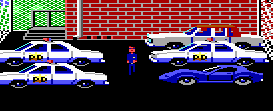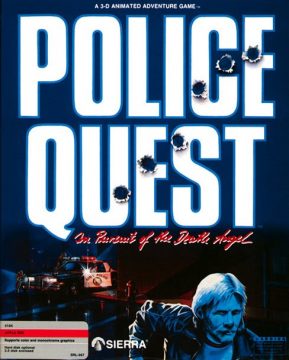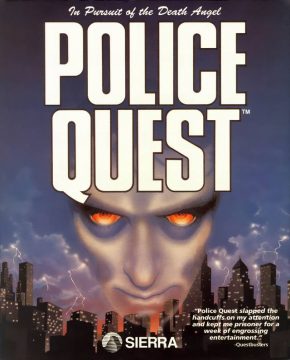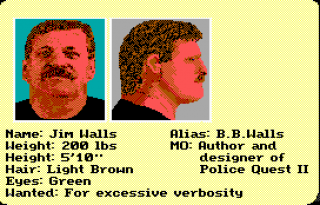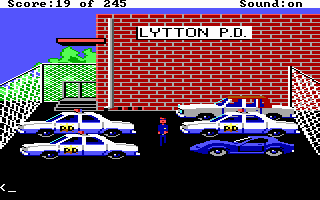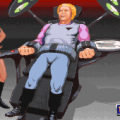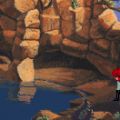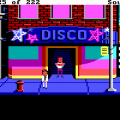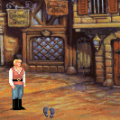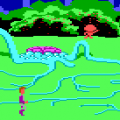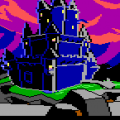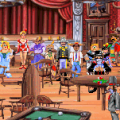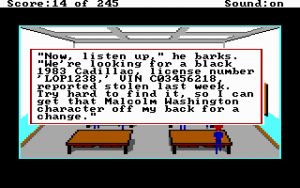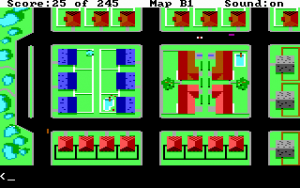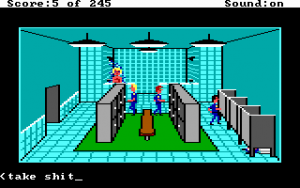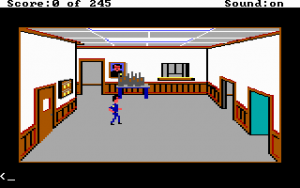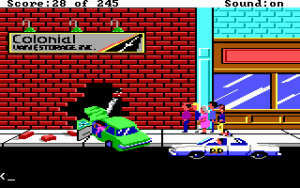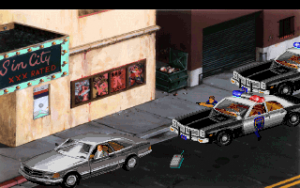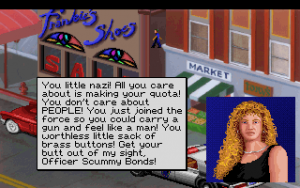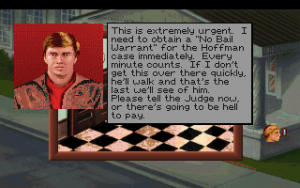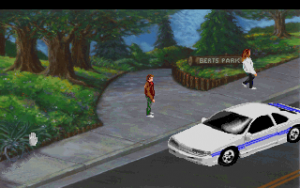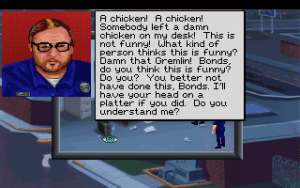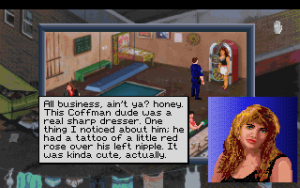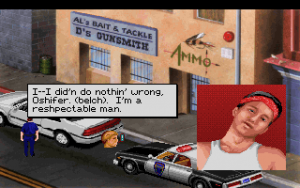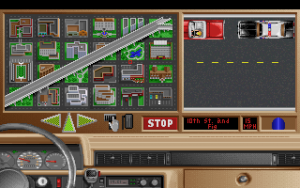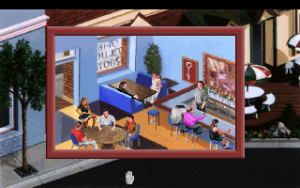- Police Quest: In Pursuit of the Death Angel
- Police Quest 2: The Vengeance
- Police Quest 3: The Kindred
- Police Quest: Open Season
- Police Quest: SWAT
- Blue Force
In 1986, Sierra founder Ken Williams met Jim Walls, a California police officer. Jim had recently retired, partially as a result of a traumatic shoot out. Ken found this exciting – he wanted to expand his line of adventure games beyond fantasy-oriented titles like King’s Quest and Space Quest, so he made Jim an offer – to design a game based on his experiences in the police force, and try to make it as realistic as possible. Thus, Police Quest was conceived.
Police Quest is a bit different from Sierra’s other series, and indeed, most adventure games in general. Since the game takes place in the real world, the “puzzle” solutions involve following proper police procedure rather than lateral thinking. As a patrolman, you chase down speeders, write tickets, and haul in drunk drivers. As a detective, you’ll spend more time taking samples of evidence than MacGuyvering different items (for the most part – this rule is occasionally violated). This down-to-earth approach has given it the reputation of being a somewhat strict, droll experience, one that’s more focused on following rules than doing anything fun. To an extent, that’s true – there are some exciting parts, but sometimes the game takes too long to get to them. And sometimes it goes overboard with the rules, like a part in Police Quest 2, where you need to press the traffic signal button before crossing a street every single time or else you’ll get run over by a car. But as the series progressed, it eventually drifted away from boring stuff and fell into the groove of an ‘80s cop movie, even if the writing was never more than adequate.
The series has had a bit of a bumpy history, though. Jim Walls left Sierra around Police Quest 3, with Daryl Gates, former Los Angeles police chief, replacing him as a consultant. This began a marked shift in tone for the series. The next entry focused entirely on SWAT tactics in a full motion video-based game, and then moved further away from its adventure game roots by turning it into a real time strategy game. By the time SWAT 3 rolled around, the series had morphed into a tactical first person shooter, bearing almost no resemblance to the games that spawned it.
The city of Lytton, California used to be such a nice place – good people, clean streets, and safe neighborhoods. Time has not been kind to it, however, and a burgeoning criminal element has taken to the streets, increasing both violent crime and drug usage. It’s under these conditions that Sonny Bonds, of the Lytton Police Department, takes up the badge and enforces the law. Though he begins as a regular patrolman, he’s eventually promoted to a detective in the Narcotics department, and spearheads the investigation to take down the city’s drug kingpin – Jessie Bains, AKA The Death Angel.
Police Quest is a bit different in the way it approaches its problem solving – rather than obtuse inventory puzzles, practically every obstacle can be overcome by following proper police procedure. Some of these make perfect logical sense – don’t handcuff a perpetrator from the front, don’t let pretty blondes try to flirt their way out of a traffic ticket, and don’t bring your firearm into the prison when processing a detainee. You also have to remember to radio for help when necessary and don’t randomly shoot people without cause, unless you want to get reviewed by Internal Affairs. There are, on the other hand, some potential snags, to make sure that you’re reading the manual. If you don’t fully inspect your patrol car when you pull out of the station, you’re asking for a flat tire, at least in the AGI version. (Which, for some reason or another, leads to a Game Over.)
So on one hand, Police Quest is far more straightforward than the typical adventure game of the era. But on the other hand, it’s really just kind of… boring. The first half of the game is just investigating accidents and watching for traffic violations. Referring to the manual is required for practically everything, including interpreting radio dispatch codes and booking prisoners. It gets a bit more interesting once you start interrupting drug busts and going undercover into criminal hideouts, but even then, the whole thing boils down to procedure, procedure, procedure. If there’s any game that could potentially crush a kid’s action hero dreams of being a policeman, it’s this one.
Like most of Sierra’s earlier games, Police Quest comes in two flavors – the original 1987 AGI release and the updated 1991 SCI release. Fundamentally they follow the same plot, but the SCI release is obviously much nicer to look at and easier to navigate. Some minor things have changed, like the names of certain locations and characters, and some puzzles have been altered too. For some reason, taking a shower is now mandatory in the SCI version, whereas it just gave you extra points before. When booking suspects in the AGI version, all you had to do was type in the charge, but in the SCI version you need to look up numerical violation codes in the manual. And some other puzzles have been simplified – in the AGI version you need to convince a judge to give you a no bail warrant by showing a perpetrator’s file, then by showing an FBI poster and noting they have the exact same tattoo. In the SCI version, you only need to show him the file. At the end of the game, you need to go undercover and play a game of poker with the Death Angel. This is a fairly long (and annoying) minigame in the AGI version, but the SCI one lets you skip it.
Each version features drastically different driving segments, too. A good chunk of Police Quest is spent in these birds-eye view scenes, as you cruise around the streets of Lytton in your patrol car. In the AGI version, you directly control your car, which is maybe three pixels in size. It’s pretty far from realistic, considering you can immediately turn around simply by pressing the arrow keys in the opposite direction. In these scenes, you need to stay on the narrow roads and watch out for cars, as bumping into anything will cause immediate death. You also need to watch for traffic signals, because running a red light without your siren on is an offense which will immediately end your game.
The SCI version revamps this to make it much simpler. You don’t directly control your car, but instead, it runs on autopilot, and you just control your blinkers to indicate when you want to turn. But even when you click on the “gas pedal” icon to speed up, your car still moves remarkably slowly, and getting from one side of the town to the other takes far, far too long. It’s also possible to miss turns, and since you can’t turn around on the spot, you need to run around the whole block to get to your intended destination. Occasionally, the red “stop” icon will also light up, requiring that you hit the “brake” icon before you get to an intersection. If you don’t, you’ll crash and a message will say, calmly, “You die.” It will then politely restart you a few seconds before your crash, so you can’t actually get killed in these segments at all. At least this version lets you look at the buildings and street names to get a bearing on your surroundings. The AGI version, on the other hand, requires that you refer to the map bundled in the packaging. This redesigned system acknowledges that the original version was a pain, but instead of being really frustrating, now it’s just really boring.
The writing and dialogue has been greatly expanded in the SCI version, but most of it is quite clichéd and a bit silly. There’s some pretty ridiculous stuff in both versions, like Sonny’s high school-crush-turned-prostitute, who acts as an informant, or the hot-headed police sergeant whose office is terrorized by a chicken. And although you get a partner once you transfer to narcotics, she mostly just says “good luck!” and then saunters out of the room, leaving you to your own devices. She shows up later to help with a bust or two, but her involvement is extremely minimal. In the end, though, the VGA version is mostly preferable. The character designs (mullets and large, frizzy hair abound!), the cheesy Miami Vice-style soundtrack, and the “war on drugs” alarmism all distinctly date the game as a product of the late ‘80s/early ‘90s. While unintentionally goofy, this keeps the whole experience from becoming too droll.
Screenshot Comparisons
